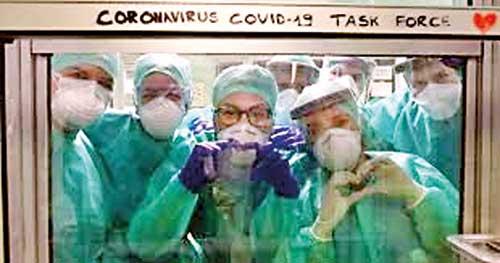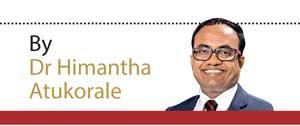16 Nov 2020 - {{hitsCtrl.values.hits}}
Anxiety levels and Covid-associated social stigma seem to be more dangerous than the disease itself
A lot has been written on the COVID-19 pandemic. Many of these portray the dangers of acquiring the  infection. It is no secret that anxiety levels and the social stigma associated with this virus are more dangerous than the disease itself.
infection. It is no secret that anxiety levels and the social stigma associated with this virus are more dangerous than the disease itself.
We are witnessing a race against time in discovering an effective vaccine or cure. But have we put much thought into “producing” health care workers at a rapid pace? Has world news featured heads-of-states declaring they have doubled their investment in medical education? If a country runs out of doctors, nurses and paramedical staff during this pandemic, even effective medication will be of no use. Even as I write this article, while working at a Teaching Hospital, most of the medical student training programmes have been halted. The nursing training schools have closed down. There will be an unavoidable crisis in human resources unless we work out an urgent solution.
The brain drain of health care workers
 In July the British Embassy in Colombo unveiled a “Health and Care Visa” scheme for Sri Lankan doctors and families to obtain fast-track visas. The General Medical Council (GMC) of the UK sent a series of automated emails to Sri Lankan doctors who were earlier employed at the NHS-UK, promising to renew the registration free of charge. It seems that the UK health services have plans for expanding their medical workforce through foreign recruits. The UK is not the only country that planned on expanding health care manpower. Sri Lanka has not yet planned to reinitiate its medical workforce clinical training programmes. Except for final-year medical students, the ward-based hands-on training for other batches has been postponed indefinitely.
In July the British Embassy in Colombo unveiled a “Health and Care Visa” scheme for Sri Lankan doctors and families to obtain fast-track visas. The General Medical Council (GMC) of the UK sent a series of automated emails to Sri Lankan doctors who were earlier employed at the NHS-UK, promising to renew the registration free of charge. It seems that the UK health services have plans for expanding their medical workforce through foreign recruits. The UK is not the only country that planned on expanding health care manpower. Sri Lanka has not yet planned to reinitiate its medical workforce clinical training programmes. Except for final-year medical students, the ward-based hands-on training for other batches has been postponed indefinitely.
Developmental status
The World Bank considers Gross National Income (GNI) when categorising countries as low, lower-middle, upper-middle, and high. Sri Lanka falls into the lower-middle-income group. This classification system based on finances sounds quite primitive. We are yet to identify a classification based on human wellbeing indices. These might be difficult to measure, but at the same time are the most reliable mechanisms of knowing how people are faring. The US, which has a high-income level, did quite poorly when facing the COVID-19 pandemic. Civil unrest in the US due to racial discrimination was at its helm in the past few months. Still, the World Bank country classification system considers the US a highly developed country, purely based on the assets they own. Of the top twenty countries which have the highest number of COVID-19 deaths per one million population, ten are within Europe.
In contrast, certain countries in sub-Saharan Africa have fared better. Good examples of preparedness for the COVID-19 pandemic was observed in Mauritius and South American Uruguay. Vietnam is also tackling the infection very cleverly. In future, the development indices of any country will be defined by its number of skilled health care workers. If we consider the wellbeing of citizens, there is no doubt that the latter three countries consist of populations which are healthier than those from Europe or the US.
"Creating skilled doctors and paramedics are a worthy investment. Some junior doctors who are capable of research might find permanent solutions for future pandemics. Reinitiating medical workforce training with adequate safety measures should be made an immediate priority."
Building a powerful medical workforce
In the face of a pandemic, we need a capable and qualified medical workforce. Skilled doctors, nurses, health care assistants, administrators, laboratory technicians and public health care workers are a must to control a pandemic. It is proven that uncontrolled non-communicable diseases cause fatalities in a COVID-19 patient. Health care workers can be efficiently deployed to control these diseases, thereby lowering the number of deaths.
If the medical faculties halt their clinical training programmes, this would result in a dearth of junior doctors. As doctors have a higher chance of acquiring COVID-19 than other citizens, the health ministry should own a reserved group to deploy at short notice. The same goes for all the other paramedical staff. Therefore, instead of halting preparatory programmes, the government might have to consider avenues to expedite clinical training. With the provision of protective equipment like face shields, N95 masks, hand sanitizers, it is well worth the risk to recommence ward-based training.
Creating skilled doctors and paramedics are a worthy investment. Some junior doctors who are capable of research might find permanent solutions for future pandemics. Reinitiating medical workforce training with adequate safety measures should be made an immediate priority.
The writer is a Consultant in Rheumatology and Rehabilitation at the Anuradhapura Teaching Hospital.
30 Nov 2024 3 hours ago
30 Nov 2024 4 hours ago
30 Nov 2024 7 hours ago
30 Nov 2024 9 hours ago
30 Nov 2024 30 Nov 2024